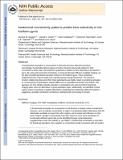| dc.contributor.author | Koldewyn, Kami | |
| dc.contributor.author | Reynolds, Gretchen | |
| dc.contributor.author | Saygin, Zeynep M. | |
| dc.contributor.author | Osher, David E. | |
| dc.contributor.author | Gabrieli, John D. E. | |
| dc.contributor.author | Saxe, Rebecca R. | |
| dc.date.accessioned | 2014-07-28T20:49:24Z | |
| dc.date.available | 2014-07-28T20:49:24Z | |
| dc.date.issued | 2011-12 | |
| dc.date.submitted | 2011-09 | |
| dc.identifier.issn | 1097-6256 | |
| dc.identifier.issn | 1546-1726 | |
| dc.identifier.uri | http://hdl.handle.net/1721.1/88514 | |
| dc.description.abstract | A fundamental assumption in neuroscience is that brain structure determines function. Accordingly, functionally distinct regions of cortex should be structurally distinct in their connections to other areas. We tested this hypothesis in relation to face selectivity in the fusiform gyrus. By using only structural connectivity, as measured through diffusion-weighted imaging, we were able to predict functional activation to faces in the fusiform gyrus. These predictions outperformed two control models and a standard group-average benchmark. The structure–function relationship discovered from the initial participants was highly robust in predicting activation in a second group of participants, despite differences in acquisition parameters and stimuli. This approach can thus reliably estimate activation in participants who cannot perform functional imaging tasks and is an alternative to group-activation maps. Additionally, we identified cortical regions whose connectivity was highly influential in predicting face selectivity within the fusiform, suggesting a possible mechanistic architecture underlying face processing in humans. | en_US |
| dc.description.sponsorship | United States. Public Health Service (DA023427) | en_US |
| dc.description.sponsorship | National Institute of Mental Health (U.S.) (F32 MH084488) | en_US |
| dc.description.sponsorship | National Eye Institute (T32 EY013935) | en_US |
| dc.description.sponsorship | Poitras Foundation | en_US |
| dc.description.sponsorship | Simons Foundation | en_US |
| dc.description.sponsorship | Ellison Medical Foundation | en_US |
| dc.language.iso | en_US | |
| dc.publisher | Nature Publishing Group | en_US |
| dc.relation.isversionof | http://dx.doi.org/10.1038/nn.3001 | en_US |
| dc.rights | Creative Commons Attribution-Noncommercial-Share Alike | en_US |
| dc.rights.uri | http://creativecommons.org/licenses/by-nc-sa/4.0/ | en_US |
| dc.source | PMC | en_US |
| dc.title | Anatomical connectivity patterns predict face selectivity in the fusiform gyrus | en_US |
| dc.type | Article | en_US |
| dc.identifier.citation | Saygin, Zeynep M, David E Osher, Kami Koldewyn, Gretchen Reynolds, John D E Gabrieli, and Rebecca R Saxe. “Anatomical Connectivity Patterns Predict Face Selectivity in the Fusiform Gyrus.” Nat Neurosci 15, no. 2 (December 25, 2011): 321–327. | en_US |
| dc.contributor.department | Harvard University--MIT Division of Health Sciences and Technology | en_US |
| dc.contributor.department | Massachusetts Institute of Technology. Department of Brain and Cognitive Sciences | en_US |
| dc.contributor.department | McGovern Institute for Brain Research at MIT | en_US |
| dc.contributor.mitauthor | Saygin, Zeynep M. | en_US |
| dc.contributor.mitauthor | Osher, David E. | en_US |
| dc.contributor.mitauthor | Koldewyn, Kami | en_US |
| dc.contributor.mitauthor | Reynolds, Gretchen | en_US |
| dc.contributor.mitauthor | Gabrieli, John D. E. | en_US |
| dc.contributor.mitauthor | Saxe, Rebecca R. | en_US |
| dc.relation.journal | Nature Neuroscience | en_US |
| dc.eprint.version | Author's final manuscript | en_US |
| dc.type.uri | http://purl.org/eprint/type/JournalArticle | en_US |
| eprint.status | http://purl.org/eprint/status/PeerReviewed | en_US |
| dspace.orderedauthors | Saygin, Zeynep M; Osher, David E; Koldewyn, Kami; Reynolds, Gretchen; Gabrieli, John D E; Saxe, Rebecca R | en_US |
| dc.identifier.orcid | https://orcid.org/0000-0003-2377-1791 | |
| dc.identifier.orcid | https://orcid.org/0000-0003-1158-5692 | |
| dc.identifier.orcid | https://orcid.org/0000-0002-2191-0340 | |
| mit.license | OPEN_ACCESS_POLICY | en_US |
| mit.metadata.status | Complete | |
